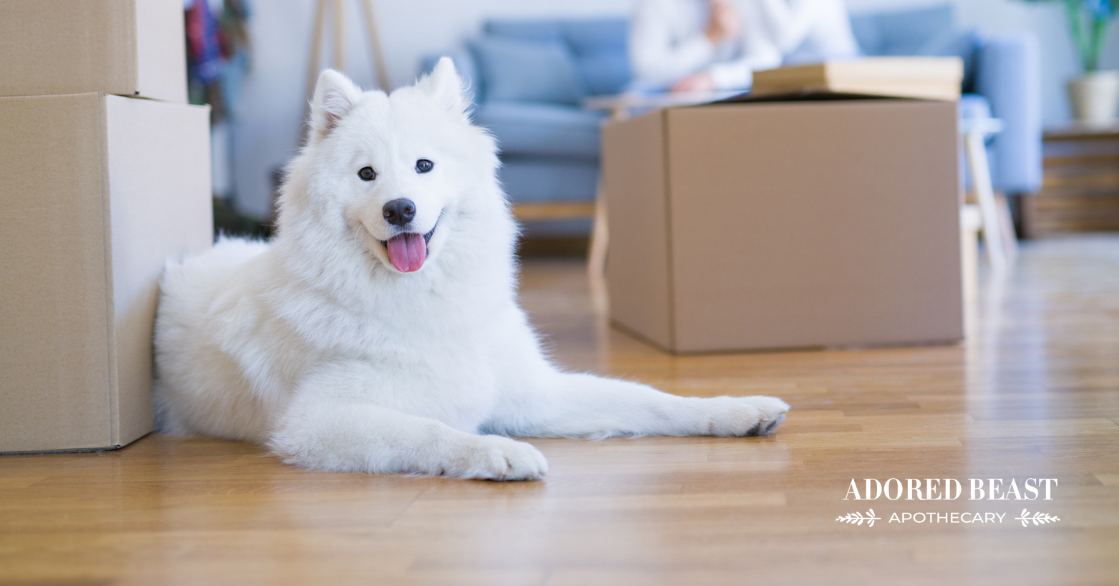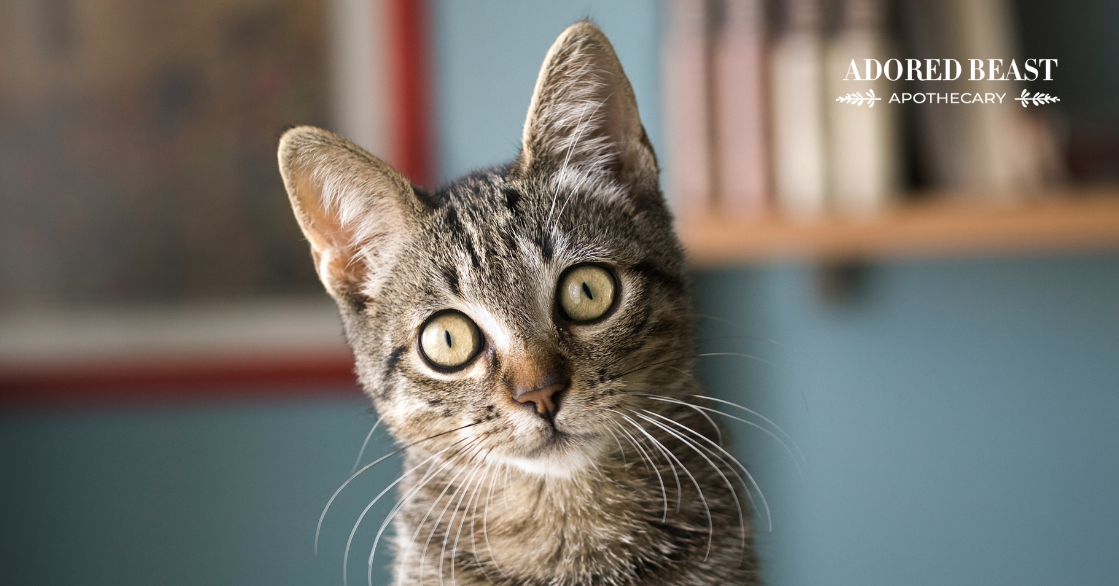Bladder infections in dogs and cats are fairly common. They can be painful, and are not something that will just go away on their own.
And unfortunately, sometimes they’re mistaken for other issues that look the same.
So, when your cat starts crying when she pees, or your dog is asking to go out 25 times a day, what’s going on and what can you do?
What is a Bladder Infection in Dogs and Cats?
A bladder infection is exactly what it sounds like: an infection in the bladder. Typically, they’re caused by bacteria traveling up the urethra and into the bladder. Our pets can pick up bacteria from the environment, swimming, or even spread from their own rectal or genital areas.
Are bladder infections in dogs and cats the same as a UTI? No. Bladder infections are a type of UTI, but not all urinary tract infections are bladder infections. A UTI is an infection in one or more places in the urinary tract, whereas a bladder infection is a UTI that’s only in the bladder.
For more on UTIs, read this next.
There are several symptoms you might notice when it comes to bladder infections in dogs and cats.
If there is a sense of urgency or frequency, that’s usually a sure sign. WIth cats, you’ll often see them peeing outside the litter box. If your animal is asking to go out a lot, going out and only peeing a tiny bit, but then asking to go back out within the hour, or even peeing in the house because they can’t make it outside, those are typically signs that something is going on in the urinary tract.
Other signs include:
- Pain or difficulties urinating (crying when urinating)
- Blood in urine
- Straining to urinate
- Cloudy or strong-smelling urine
- Licking the genital area
- Fever
- Increased thirst
- Lack of energy
If you notice any of these symptoms, it’s time to figure out what the cause is.
First: Is it Really a Bladder Infection?
Make sure that it truly is an infection and not something else.
The biggest ‘mistaken identity’ with bladder infections in cats is interstitial cystitis. Although it can look like a bladder infection, interstitial cystitis is a chronic condition that causes bladder pressure, bladder pain, and sometimes pelvic pain. The bladder walls become inflamed, and the pain ranges from mild discomfort to severe, unimaginable pain.
This is usually an auto-immune disease and not an infection.
Cats get this a lot. Dogs can get it as well, but it’s more common in cats. And unfortunately, far too often it’s treated with antibiotics. Antibiotics are meant to treat an infection, not an auto-immune disease, so they won’t help in this situation. In fact, they’ll do more harm than good, destroying gut bacteria and leaving the body vulnerable. That’s why it’s so important to make sure that what you think is a bladder infection is actually a bladder infection, not something else.
You also want to make sure it’s not spay incontinence. This is an issue when your dog has a reduction in estrogen, or sex hormones in general, and starts to lose muscle control of the sphincter and bladder. Again, you don’t want to be treating spay incontinence with antibiotics.
Puppy vaginitis can also look a lot like a bladder infection as well. In this case, a puppy will be licking their genitals and urinating more often.
With cats in particular, make sure there isn’t a urinary blockage. This is a life-threatening situation (and we’ll cover that in a little bit).
The best way to be sure is to bring a urine sample to the vet for testing.
***NOTE: It’s really important, with an of the symptoms above, to make an appointment with your vet as soon as you possibly can – the same day is ideal.
How to Collect a Urine Sample
The first urine in the morning is the best one if you can get it.
The best (and easiest) way to collect a urine sample from a dog is to use a sterilized stainless steel soup ladle:
- Follow your dog around the yard until they’re ready to go.
- Move in slowly so you don’t spook your animal.
- Try to catch the urine mid-stream.
- It’s ok if the bottom of the ladle touches the ground.
- Don’t touch your animal’s body as they’re peeing.
- Transfer it from the ladle to a sterilized container.
For kitties it’s always a good idea to have Nosorb on hand – this is a sterile kitty litter that doesn’t absorb urine. You’ll find it at your veterinary clinic. To a cat, it feels like regular litter, but you can use it to easily collect urine. To use it:
- Empty out the litter box and completely disinfect it.
- Put the Nosorb in, and leave your cat alone to do her business.
- Once she has peed, you can just take the litter box and pour everything – Nosorb and urine – back into the container the Nosorb came in.
You want to get the sample to your vet as soon as you can, but if you can’t go right away, keep it in the fridge until you can. (It should be within 6-12 hours.)
Ask for a culture and sensitivity from the urine sample. This will show if it’s true bacteria and not just bacteria from contamination. Sometimes there will be bacteria from the environment, but this should be fairly easy to detect from the lab results.
Your vet will be able to prescribe the correct antibiotic, if one is even needed. This is really important because constant use of the wrong ones can lead to antibiotic resistance – and destroy the microbiome, leading to chronic disease.
Homeopathic Remedies for Bladder Infections in Dogs and Cats
With these remedies, you can start each one before you even get to the clinic. If your animal starts off like this, but you can’t get an appointment until the next day, you don’t want to leave them in pain.
If there is a sense of urgency and increased frequency, start off with a combination of:
- Arnica 200C
- Aconite 200C
- Nux Vomica 200C
- Cantharis 200C
**These are good remedies to have in your kit if you have a cat (a dog too of course)!
Give this every 1/2 hour, twice, then every 2 hours, 2 more times, then every 8 hours, four times.
If it is not working within 4 hours, or your animal is getting worse, stop.
For young animals, ones who are clingy and seeking attention, and if the urine is stringy or with mucus, but are not showing that same urgency and frequency as above, replace the Cantharis with Pulsatilla 200C.
With cats in particular, if these remedies have not helped within 4 hours, you HAVE to take your cat to the vet. It’s crucial to rule out a life-threatening blockage. If you have a male cat that is scratching at the litter box and no urine is coming out, and they’re constantly licking at their genitals, you need to head to the vet right away as an emergency. Just as you’re putting them in the carrier, give the remedies.
Urinary Blockage? Next Steps
With bladder infections in dogs, but more specifically cats, a urinary blockage is a big problem.
If, once you get to the clinic, your veterinarian says yes, your cat is blocked, they may recommend a catheter. At this point, ask your vet if pain medicine and a muscle relaxant can be tried first. Ask for their personal opinion on your unique situation.
If they say “absolutely no way, your cat is totally blocked, we need to clear it out right away” – do it! As I mentioned, this is a life-threatening situation.
However, if they say “there is a blockage, but the badder is small, so sure, let’s try the pain meds and muscle relaxant first and see if they’ll pee on their own” – do it.
Most of the time, blockages happen with male cats and they come from crystals. Female cats get crystals just as often as male cats, but they don’t have the teeny tiny urethra. When a cat has crystals, what winds up happening is that when the cat is urinating, it irritates the lining of the urethra. Then the urethra gets inflamed, getting even thinner. Then it starts to spasm, and nothing can go anywhere. The crystals get stuck, blocking the urethra.
Now, here’s why this is important. If the crystals get stuck, when you use a catheter, you’re trying to push through them. A lot of time this causes scarring in the urethra. Ultimately, your cat can be more prone to getting blockages than before. So, if there’s a chance that the drugs may work, and it’s safe to wait and see if they do, it’s always better.
But again, if your vet says no, you absolutely have to unblock it now – do it. Don’t wait.
When an animal does have crystals, you want to try and balance your animal’s pH (ask your vet where they feel your individual animal’s ph should be). When the pH is too alkaline, struvite crystals can form, but if it’s too acidic, oxalate crystals will form. With dogs and cats it’s vital that the pH balance is within the normal range of their species. One of the easiest ways to do this is with a balanced, species-oriented, raw meat diet.
You can also purchase urine ph check strips – ask your vet for these – to check those levels are home. You can also check the drugstore for them as well. This way you can get ahead of the crystal formation and maintain bladder health.
Herbs and nutraceuticals can also help:
- cranberry (to increase acidity)
- slippery elm and marshmallow root (to help keep things moist and soft, and not inflamed)
- homeopathic remedies berberis and hydrangea (to help support the dissolution of crystals)
- N-Acetylglucosamine (NAG) – to decrease inflammation of the lining of the urethra and the bladder walls)
Our Easy Peesy Protocol was developed specifically for bladder health and urinary crystals, to help discourage crystal formation, and help support urinary tract health.
The urinary tract (including the bladder) can handle quite a bit, but once an infection sets in, your pet will be in pain. Thankfully, treating bladder infections in dogs and cats can be fairly straightforward but it’s important to have the correct diagnosis and be able to navigate and maintain bladder health at home. Good luck <3











![[RESEARCH] Is Herbicide Safe for Dogs?](https://blog.adoredbeast.com/wp-content/uploads/2025/06/herbicides-safe-for-dogs-103x55.png)
